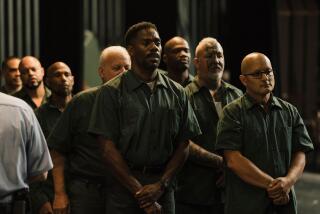MOVIE REVIEW : Lust, Crime Unite Doomed Teen-Age Lovers in ‘Swoon’ : The story is based on the ‘20s Loeb-Leopold case involving two Chicago youths who killed a 13-year-old boy.
Tom Kalin’s “Swoon” (selected theaters) is an inventive low-budget black-and-white movie about killers in love, a doomed couple united by lust and crime whose murderous idyll is cut short by the outside world.
The theme puts it in a rich film noir tradition, in the same vein as “Gun Crazy,” “Double Indemnity” or “The Honeymoon Killers.” But Kalin has an extra psychological screw-twist. His protagonists are, as the film’s trailer announces, “geniuses,” “Jews” and “queers.” And that’s what most concerns the film: the “otherness” of the killers, and the way society paints their crime as a logical eruption of deviance, sexual or otherwise.
The movie’s subject is factual: the Loeb-Leopold case, the notorious 1924 “thrill killing” by a pair of Chicago teen-agers, both from fabulously wealthy Jewish families, who went on an eroticized crime rampage that ended in the kidnaping and murder of a 13-year-old boy, eventual capture and a sensational trial. For Kalin, his murderous lovers are as much sinned against as sinning, and this controversial attitude--probably fueled by the AIDS epidemic--splits his movie in two. As a dark poem of love and madness, “Swoon” has an eerie power. As social polemic, it gets arch and strained.
Kalin’s moral stance may bewilder some audiences, who are, after all, being asked to sympathize with the propagators of a heinous crime. Wanting for nothing, both prodigiously intelligent--at 18, Loeb was then the youngest graduate in the history of the University of Michigan--they killed for kicks, for aesthetics, and to seal their erotic bond as two imaginary Nietzschean Ubermenschen.
As the film shows, their “genius” was a delusion. During the murder, they went “blood simple” and only Clarence Darrow’s spellbinding courtroom eloquence saved their lives. Loeb, the psychopath of the two, was killed in prison in a shower brawl; Leopold went through a famous rehabilitation, was paroled and ended his life in exemplary fashion as a medical missionary in Puerto Rico.
Loeb and Leopold have been portrayed in the movies before--most notably by Alfred Hitchcock and Arthur Laurents in “Rope” and Richard Fleischer and Meyer Levin in “Compulsion”--but “Swoon” takes a different tack from either. It doesn’t view them from outside. It pulls us into their world, revels in their passion--and while it doesn’t shortchange the horror of their crime, it’s more concerned with the tidal wave of homophobia breaking around them.
Kalin attacks the notion, common in 1924, that the pair were driven to murder by “inversion.” Yet he also rejects the Nietzschean rationale of “Rope,” and he doesn’t nose much into the idea that not homosexuality but wealth itself was their perversion; that they were spiritual ancestors of Bret Easton Ellis’ yuppie maniac in “American Psycho.” Instead, Kalin strips the relationship to its primal sadomasochistic core: “Dickie” Loeb (Daniel Schecter) is a narcissistic killer-stud who gets off on crime, and “Babe” Leopold (Craig Chester) is his homelier adorer, going along for the murder-ride out of helpless infatuation.
It’s a keen insight, and Chester is perhaps the most convincing screen Nathan Leopold ever. Watching his drooping eyes and awkward, tentative body language, we can understand his enslavement to the confident and conscienceless Loeb. We see Loeb, in some sense, through Leopold’s rapt vision--as a dangerous, if flawed, Adonis. This links “Swoon” up with the other “Gay New Wave” films, “Poison,” “The Living End” and Christopher Munch’s “The Hour and Times”--with its more balanced, if equally revisionist, view of John Lennon and Brian Epstein.
The movie is drenched in style. Kalin mixes real or mock-documentary footage with spectral, high-contrast imagery that he and cinematographer Ellen Kuras modeled on Carl Dreyer films like “Vampyr” and “The Passion of Joan of Arc.” We’re jolted in and out of these “realistic” or visionary modes: a ring exchange in a cavernous cityscape, the horrific woods that backdrop the murder, a campy theatrical with deadpan flapper transvestites, and the sudden, surreal appearance of Loeb and Leopold’s bed in the courtroom.
Strangely, in “Swoon” (Times-rated mature for sensuality and violence), the imagined scenes--the murder and lovemaking--often seem paralyzingly real; and the documentary footage or trial scenes a bit phony or campy, with the actors too intent on exposing the stupidity of their own speeches. Kalin wants to expose the absurdity of ‘20s prejudice, to link it to today. But the satire and polemic are often less convincing than the dreams and madness. The movie thinks best when it swoons. It can’t make us sympathize with murderers, but it can make us see some of the madness of a society that brands all deviance as potentially homicidal.
‘Swoon’
Daniel Schlachet: Richard Loeb
Craig Chester: Nathan Leopold Jr.
Ron Vawter: State’s Attorney Crowe
Michael Kirby: Detective Savage
A Fine Line Features release. Director/Screenplay/Editor Tom Kalin. Producers Christine Vachon, Kalin. Executive producers Lauren Zalaznick, James Schamus. Cinematographer Ellen Kuras. Costumes Jessica Haston. Music James Bennett. Production design Therese Deprez. Running time: 1 hour, 36 minutes.
Times-rated: Mature (sensuality, violence).
More to Read
Only good movies
Get the Indie Focus newsletter, Mark Olsen's weekly guide to the world of cinema.
You may occasionally receive promotional content from the Los Angeles Times.










